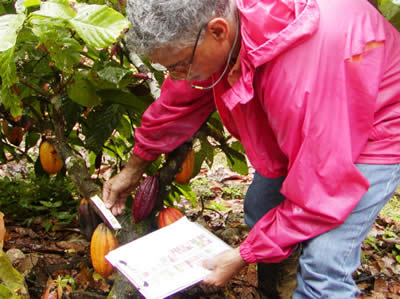Fingerprinting
Activities | Achievements | Staff
Objectives
- Identify genetic fingerprints and phylogeny.
- Identify errors in the germplasm collection.
- Provide a repository which can be used to identify accessions in any country.
- Develop molecular markers linked to various characters.
CRC used several methods for fingerprinting in the past.
- Isozymes (1990-98)
- SSRs (2001-present)
- SNPs (2009-present)
CRC has collaborative projects with CIRAD, France, and the United States Department of Agriculture (Beltsville, MD).

Fingerprinting Theobroma cacao germplasm trees (accessions) is done by extracting the genetic material (DNA) from the leaves of the cacao trees and processing the material to obtain a genotype or genetic fingerprint.
Fingerprinting is used to verify trees and maintain uniformity of plots in the germplasm collection, the International Cocoa Genebank, Trinidad.
It is also a tool to characterise the amount of variation existing within the collection and to "tag" (and follow the inheritance of) important phenotypic traits such as yield and disease resistance for use in breeding programs to produce enhanced trees.

















